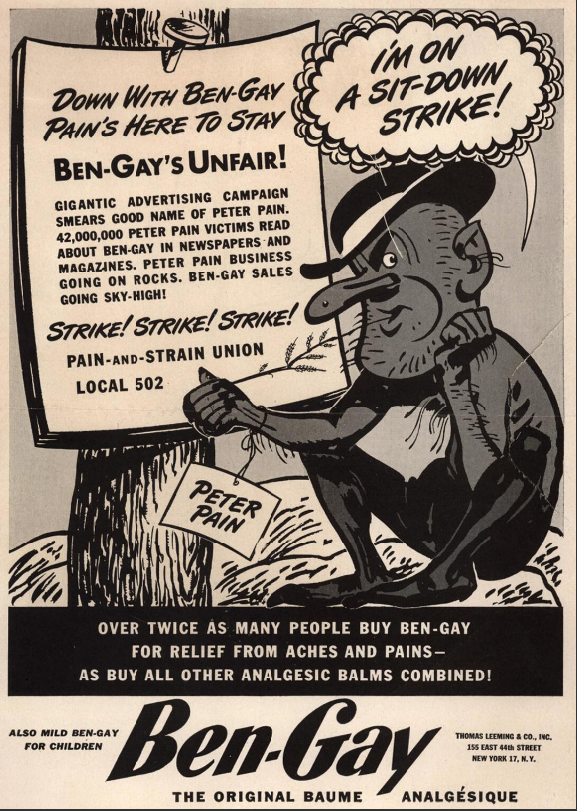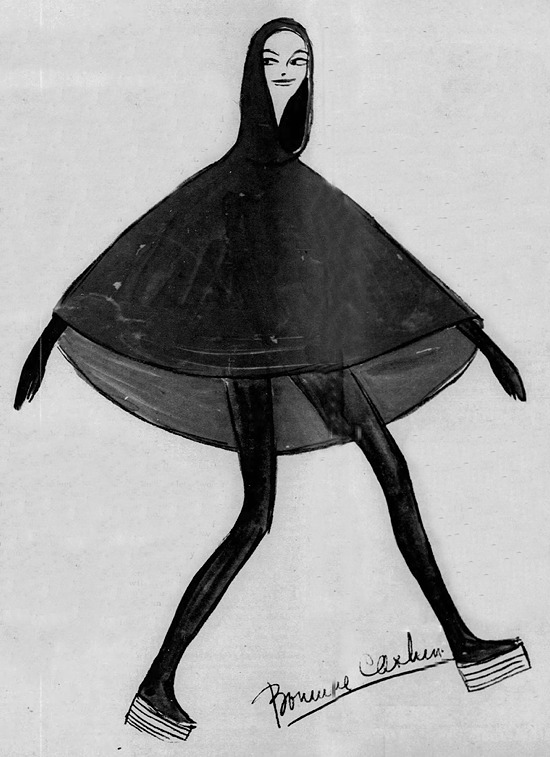Weird Universe Archive
January 2019
January 2, 2019
Follies of the Madmen #404

Not entirely sure why any company would emphasize the sufferings of its "antagonist" so dramatically. It would be like saying, "Poor germs! Doctors are killing them all!"
Source.
Posted By: Paul - Wed Jan 02, 2019 -
Comments (0)
Category: Anthropomorphism, Advertising, Corporate Mascots, Icons and Spokesbeings, 1940s, Pain, Self-inflicted and Otherwise, Fictional Monsters
January 1, 2019
Fashion predictions for 2019 - from 1969
Back in 1969, fashion designer Bonnie Cashin offered both a pessimistic and optimistic prediction for how people would be dressing in 2019. I'm guessing her illustration is supposed to show the optimistic one.The pessimistic prediction:
If the very air we breathe continues to be poisoned... If the earth and sea food-yields are destroyed... If noise continues to batter the eardrums... If violence continues unabated... If the population continues to explode...
Then each of us may have to wear an environmental covering just to survive. This would be a kind of life-preserving incubator which we would be put into at birth, never to leave. This would serve as an individual habitat. There might be no private homes as we know them. Communities of people would be "stored" for sleeping in giant, multi-level containers, probably according to income level.
In this gear, perhaps called an "environmode," there would be an oxygen system, a speaker system and other devices to maintain bodily functions and self-protection. It would be made of some still-to-be-invented material which articulates with movements of the body. It would have to be close-fitting, but it might be very light and transparent. Underneath would be worn a second-skin garment. In this, the individual might be able to express some personal taste in the choice of color and texture.
The fashion market as we know it would become extinct. A market for new kinds of accessories would come into being, individuality being possible in headgear, oxygen bag, the kind of ray gun you carry and such.
Then each of us may have to wear an environmental covering just to survive. This would be a kind of life-preserving incubator which we would be put into at birth, never to leave. This would serve as an individual habitat. There might be no private homes as we know them. Communities of people would be "stored" for sleeping in giant, multi-level containers, probably according to income level.
In this gear, perhaps called an "environmode," there would be an oxygen system, a speaker system and other devices to maintain bodily functions and self-protection. It would be made of some still-to-be-invented material which articulates with movements of the body. It would have to be close-fitting, but it might be very light and transparent. Underneath would be worn a second-skin garment. In this, the individual might be able to express some personal taste in the choice of color and texture.
The fashion market as we know it would become extinct. A market for new kinds of accessories would come into being, individuality being possible in headgear, oxygen bag, the kind of ray gun you carry and such.

New York Sunday News, Coloroto Magazine - Sep 7, 1969
The optimistic one:
If, by some lovely miracle, Washington would immediately relinquish its Model T political thinking and grant first priority to the survival of the human being... If the brilliant minds that put man on the moon are teamed with social scientists and architects on a crash program for the "scientific restructure of man on earth," by 2019 we will have triggered a renaissance that will see exploration beyond man's oldest, and newest, dreams...
The young will no longer need to look at the world through a rear-view mirror, dressing as Edwardians or gypsies or biblical characters to make their point. They will be too busy planning ahead. They will look at their bodies with pride, conducting themselves with grace.
The "in" four-letter words might be "work" and "give." And "love," in the most delightful sense. I see young people of a half century from now looking absolutely marvelous, because they reflect the great environment in which they will live. Fashion's role will be as an adjunct to the fully involved life, not a fad, not a relief from boredom or a comic relief. And not just big business.
The future look is clean, unencumbered, free and much more individual in the pure sense than fashion is today — almost, you might say, non-fashion. I see color a much greater dimension than it is now, the head-to-toe effect composed, somewhat, as a walking collage. People will be educated to this, and each person will, in a sense, be able to design himself. Cosmetics will play a large role, not so much as facial adornment but as body insulation or chemistry to protect from extreme cold or heat. This, along with actual weather control, will cancel out the need for heavy clothing and furs. Fabrics and substances yet unborn will employ technology to a creative extent that we have not yet seen. There will be more un-cut-up "dressmaking" techniques used, but the word dressmaker may well be almost extinct. The dart, the seam, the hem, the detail fittings will go into the Brooklyn Museum Design Laboratory archives, along with the obsolete government charts of sizes used in our clothing industry today. Everything will be sized small, medium and tall (not large, because obesity will be a sin). Practically all clothing will be laminated, fused, molded or knitted into shape without sewing. Another technique will be a return to simple draping and tieing — a concept still used in some "developing" countries.
I think, too, that the "layered" concept, which has long been an involvement of mine, will continue in new applications. For instance, six very thin layers of a new substances, each permeated with certain chemical coverings, could be peeled off or donned as the need requires, much like an onion. This is the concept, I think, from which space-travel clothing will evolve, and that evolution should come before 2019.
The young will no longer need to look at the world through a rear-view mirror, dressing as Edwardians or gypsies or biblical characters to make their point. They will be too busy planning ahead. They will look at their bodies with pride, conducting themselves with grace.
The "in" four-letter words might be "work" and "give." And "love," in the most delightful sense. I see young people of a half century from now looking absolutely marvelous, because they reflect the great environment in which they will live. Fashion's role will be as an adjunct to the fully involved life, not a fad, not a relief from boredom or a comic relief. And not just big business.
The future look is clean, unencumbered, free and much more individual in the pure sense than fashion is today — almost, you might say, non-fashion. I see color a much greater dimension than it is now, the head-to-toe effect composed, somewhat, as a walking collage. People will be educated to this, and each person will, in a sense, be able to design himself. Cosmetics will play a large role, not so much as facial adornment but as body insulation or chemistry to protect from extreme cold or heat. This, along with actual weather control, will cancel out the need for heavy clothing and furs. Fabrics and substances yet unborn will employ technology to a creative extent that we have not yet seen. There will be more un-cut-up "dressmaking" techniques used, but the word dressmaker may well be almost extinct. The dart, the seam, the hem, the detail fittings will go into the Brooklyn Museum Design Laboratory archives, along with the obsolete government charts of sizes used in our clothing industry today. Everything will be sized small, medium and tall (not large, because obesity will be a sin). Practically all clothing will be laminated, fused, molded or knitted into shape without sewing. Another technique will be a return to simple draping and tieing — a concept still used in some "developing" countries.
I think, too, that the "layered" concept, which has long been an involvement of mine, will continue in new applications. For instance, six very thin layers of a new substances, each permeated with certain chemical coverings, could be peeled off or donned as the need requires, much like an onion. This is the concept, I think, from which space-travel clothing will evolve, and that evolution should come before 2019.
Posted By: Alex - Tue Jan 01, 2019 -
Comments (4)
Category: Fashion, Predictions, Yesterday’s Tomorrows, 1960s
Happy New Year 2019
All the best for a happy and healthy New Year from Alex, Paul and our partners!
Posted By: Paul - Tue Jan 01, 2019 -
Comments (2)
Category: Holidays, Alex, Paul
| Get WU Posts by Email | |
|---|---|

| Who We Are |
|---|
| Alex Boese Alex is the creator and curator of the Museum of Hoaxes. He's also the author of various weird, non-fiction books such as Elephants on Acid. Paul Di Filippo Paul has been paid to put weird ideas into fictional form for over thirty years, in his career as a noted science fiction writer. He has recently begun blogging on many curious topics with three fellow writers at The Inferior 4+1. Chuck Shepherd Chuck is the purveyor of News of the Weird, the syndicated column which for decades has set the gold-standard for reporting on oddities and the bizarre. Our banner was drawn by the legendary underground cartoonist Rick Altergott. Contact Us |

